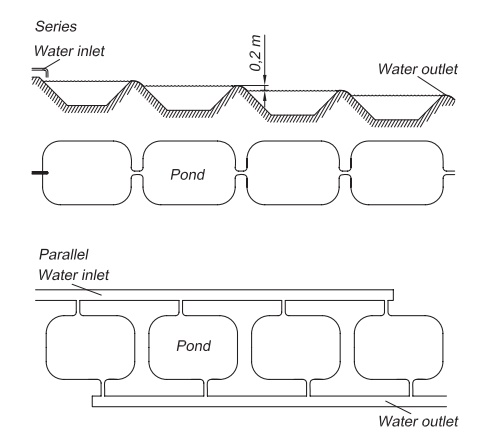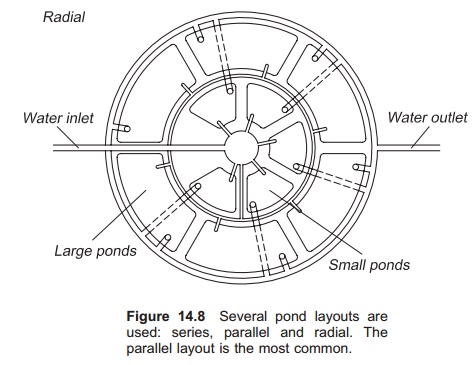Chapter: Aquaculture Engineering : Ponds
Aquaculture Pond layout
Pond layout
A farm normally
comprises several ponds. The arrangement of the ponds is important for optimal
utilization of the area, and to ensure efficient water transport, fish handling
and (eventually) feed handling. If watershed ponds are used, they must be
adapted to the ground conditions and the layout is normally predetermined. If
using levee or embankment ponds the layout is more important. Rectangular ponds
are usually best regarding utilization of the area. Four main layouts may be
used (partly from ref. 19) (Fig. 14.8):


Series ponds are constructed so that the waterflows from one
pond into the next. The advantage is that gravity can be used to ensure the
water flows though the entire farm. The main disadvantage is that the effluent
water from one pond is the inlet water to the next pond and water quality
decreases from pond to pond. Eventually disease pathogens will also follow the
water and spread disease from pond to pond as isolation of a single pond is
impossible. The water may be aerated when flowing from one pond to the next.
Parallel ponds are set out beside each other, with a common
water supply canal and a common effluent water canal. This is the most usual
layout for a pond farm. The advantages are that the water quality is the same
in each pond and it is also possible to increase and reduce the water flow to
the separate ponds.
Radial ponds are in a circle with the smallest close to the
centre and the larger ponds outside this. In this way the size of the ponds
increases with the radius of the circle. The great advantage with this system
is that fish handling is very easy. If the fry are in the inner ponds they can
gradually be moved to larger ponds when they grow and need a greater volume of
water. The empty ponds can then be restocked with new fish.
Inset ponds are small ponds placed inside a larger pond.
This method can provide a nursery pond inside a grow-out pond.
Related Topics